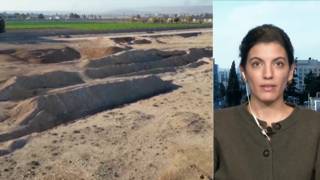
Related
Guests
- Ira Leiferresearcher in the Marine Science Institute at the University of California, Santa Barbara, and a member of the government’s Flow Rate Technical Group.
On Tuesday, BP and government officials claim that BP’s new cap system has collected over 51,000 barrels of oil since Friday. Tony Hayward has said he is hopeful the new measures would soon contain a major portion of the oil gushing out of the ruptured well, but scientist Ira Leifer says the oil may be gushing out at a rate of more than 100,000 barrels a day, a number that BP once called its worst-case scenario. Leifer is a researcher in the Marine Science Institute at the University of California, Santa Barbara, and a member of the government’s Flow Rate Technical Group. [includes rush transcript]
Transcript
AMY GOODMAN: The government has confirmed that plumes of dispersed oil from BP’s leaking well are spreading far beneath the surface in the Gulf of Mexico. The National Oceanic and Atmospheric Administration said some of the most toxic components of the oil are not necessarily rising to the surface, but are drifting through deep water in plumes that stretch some fifty miles from the gushing well. The admission by the government agency confirms what scientists have been warning for weeks and renews concerns about the catastrophic impact of the oil on marine life. Last week, BP CEO Tony Hayward had declared, quote, “The oil is on the surface. There aren’t any plumes.”
Meanwhile, Tuesday, BP and government officials claimed BP’s new cap system has collected over 51,000 barrels of oil since Friday. On Sunday, Tony Hayward told the BBC he’s hopeful the new measures would soon contain a major portion of the oil gushing out of the ruptured well.
TONY HAYWARD: As we speak, the containment cap is producing around 10,000 barrels of oil a day to the surface, which is being processed on the surface when we take in —
ANDREW MARR: So what sort of proportion is that of coming out?
TONY HAYWARD: At the moment, it’s difficult to say, but we would expect it to be the majority, probably the vast majority of the oil.
ANDREW MARR: So you think this cap will get most of the oil?
TONY HAYWARD: Well, that is our hope. We are optimizing the operation. We have a further containment system to implement in the course of this coming week, which will be in place by next weekend. So when those two are in place, we would very much hope to be containing the vast majority of the oil.
AMY GOODMAN: But a member of the government panel determining the size of the spill says 10,000 barrels of oil a day could only be a fraction of the total amount of oil spewing out of the BP’s blown-out well. Scientist Ira Leifer says the oil may be gushing out at a rate of more than 100,000 barrels a day, a number BP once called its worst-case scenario.
For more, Ira Leifer joins us now on the phone from California. He’s a researcher in the Marine Science Institute at the University of California, Santa Barbara, a member of the government’s Flow Rate Technical Group.
We welcome you to Democracy Now!, Professor Leifer. Dr. Leifer, explain what we are not hearing from the government or from BP.
IRA LEIFER: Good morning, Amy, and it’s a pleasure to be on Democracy Now! I’ve been a longtime fan and listener.
The flow rates — we’ve now been provided some good data, which has been very difficult to come from before. And this data we’re analyzing, in its absence, what I pointed out is that there’s no reason to disbelieve BP’s worst case and that it could be very large, in the 100,000-plus range, for a freely flowing pipe, which it clearly appears to be. Now, we’re going to find out what the flow rate is, at least as best as we can with the data that we’ve been given. But I’d like to point out that this is not scientific data that was collected to figure out how much flow, but this is actually data that was just from monitoring, which we’re going to try to use, and that means there’s going to be larger uncertainties than I think anyone would like. And in particular, these uncertainties mean that the ability to, as Tony Hayward suggests, to hopefully contain, we won’t be able to know as precisely as people would like to know whether this is going to happen, whether we will be able to contain the oil coming, gushing into the Gulf, or whether in fact we’ll be able to do this safely. And so, one of the things that I’ve been proposing and other scientists have proposed is to actually measure the flow using available techniques, so that any activities that go into the future can be done safely.
AMY GOODMAN: So explain again what you think the numbers are and this whole idea of of the US government using the lower estimates, the lower end of the scale, and never mentioning that that was just on the spectrum and that there’s a higher end, as well.
IRA LEIFER: Somehow there was a miscommunication, and the report that we had written, which said, based on the data, we can only come up with a lower estimate — the data was such low quality, we don’t know what the upper estimate is — somehow that was miscommunicated and released as the full range. And immediately, the University of California put a copy of the original document on our website to make it available for everyone to see and compare. And within a relatively short time, many of the statements coming out of the administration, some of them, began to reflect the new — the correct interpretation, which was what we had said.
But the other thing, and this is one of the issues I’d like to try to clarify with the audience, this is not — it’s not a pipe coming out of a big tank. It’s a very complex geologic system underneath. And it’s also being affected by activities of BP. So the flow today is not necessarily the flow tomorrow. And it’s hard to speak of a precise number, like this is the flow. So, for example, we have, from previously, forty-five minutes of video from BP, and from that, we were able to estimate — and it should be released very soon — what our range of flows is. But that only reflects that forty-five minutes. We do not know what was happening five minutes before; we do not know what was happening five minutes afterwards. And this is — and worse is that from looking at the satellite imagery of the evolution of this oil slick strongly suggests that the emission rate has been increasing since the incident occurred. And one of the things that of course has been happening is that various efforts to attempt to stop the spill could easily have had the effect of allowing greater oil to come in. So what I’m trying to say is, this is — it’s a moving target, and we’re trying to actually even keep up so that the next strategies are appropriate.
AMY GOODMAN: So, the lower-bound range, 12,000 to 25,000 barrels of oil a day, the higher range, 100,000 barrels a day, that’s more than four million gallons a day, Ira Leifer?
IRA LEIFER: It is in that range. And while there is no way to say for sure that the system is in fact dumping that much oil into the Gulf, from a geologic point of view, from a freely flowing pipe, there’s no reason it could not. This reservoir is massive, and it could easily flow that kind of oil for the next twenty or thirty years, if it was left to go unattended. So the amount of oil that could end up in the environment if measures are not successful is at what I would call unimaginable.
AMY GOODMAN: Could they just bomb the hole, bomb the hole where the oil is gushing out?
IRA LEIFER: One of the concerns, which has been released, and so I can actually talk about, but there is concern that the rock structure surrounding the pipe is not strong and could, in fact, give out. And for — I guess many of your very long-term listeners might remember, but in 1969, something like that happened here in Santa Barbara, where the oil, instead of coming up the pipe, went through the seabed and the rocks and came out of the seabed in many different areas. It’s a much harder problem, you know, to do and to solve, because you don’t have a single pipe kind of seal. So one of the very big concerns of such a suggestion is that if that damaged the rock structure around the well pipe, the oil could come right through the seabed, and instead of a leak from a single point, we could have hundreds and hundreds of small leaks spread out over a large area, moving around. Sealing those in 5,000 feet of water, making a cement pad, is so much harder.
AMY GOODMAN: Why is only BP monitoring the spill’s size? What aren’t you, the scientists?
IRA LEIFER: I think that’s an excellent question. And this is one of the areas that I and other team members have indicated, if we are to learn from this oil spill, so that when there is another one, because the reality is that you can’t engineer accidents away. There will be accidents, no matter how much we try to prevent them. And the key, of course, is that when there is an accident, you don’t let the damage occur. You keep the passenger in the automobile safe. You keep the ecosystem safe. And the scientists have not been able to come in and actually make the measurements so that we can learn from what happened, so that when there is another accident somewhere on the planet, the best science and technology can protect the ecosystem, and we would be talking about a small, but still horrible, spill rather than the very large one that we’re currently faced, where we don’t seem to have any good idea as to really how to stop it.
AMY GOODMAN: Has the US advanced in how it deals with these spills from decades ago?
IRA LEIFER: So, the answer to that is that the advancement has been painfully slow. During the event of a spill, typically, as we’re seeing now, the scientists are kept away. We have to stop the spill right away; we don’t have time to let the scientists come in and take a look. We scientists will come in after the fact, much later. There’s government support for a few years, and then it completely dries up. And little bits of research still continue, and new developments are made; however, these tend not to be implemented. So there are new technologies available that are — been developed, some of them with government money, but the industry has not done what they needed to do, which is continuously upgrade their boom systems, their monitoring system to the latest technology, so that when an accident like this occurs, they have the latest technology. I think this latest technology we have today will be available for the next accident, but we’ll be twenty years late at that point, too.
AMY GOODMAN: Isn’t it just — not just the industry’s fault? I mean, it’s up to the government to require this. The idea that both BP and the government were saying, “We couldn’t have foreseen this,” isn’t that exactly what the government should be demanding of these oil companies doing deep offshore drilling, is “What is the catastrophe scenario, and how are you going to deal with it?”
IRA LEIFER: That is exactly what the regulatory regime is supposed to ensure, and clearly has fell down in that regard in this case. But I do think this is one of the areas where, from industry’s point of view, it’s in their interest. I mean, BP is not going to come out of the current event with a big profit margin because they cut short on safety. They’re going to be feeling a lot of pain for a long time, as President Obama has indicated that he will ensure. And I think that particular bottom line of pain that they’re feeling is also a good wakeup call and incentive for safety to be brought to the forefront on industry and to have the support of government and activists and so on.
AMY GOODMAN: Dr. Leifer, we have to break. Before we do, though, explain your position in monitoring the oil flow and your key role in this oil spill in the monitoring of it.
IRA LEIFER: So, right now I would have to say — well, first off, we’re not monitoring anything. BP is providing video that they have — are collecting. And currently they seem to be quite forthcoming. Previously they were selecting the video for us to analyze, which meant that one could say BP was handing us what they want us to monitor. However, from the point of view, what there really should be at these kind of sites is some acoustic methods, whether it’s sonar or passive listening devices, or other approaches that continuously are monitoring and waiting for something to happen and then would provide a nonstop, steady data stream, so we could actually learn from what happens. If I have time just to say really quickly, these things, they’re not steady states. They belch. They have large eruptions. The blowout is kind of an example. You have to continuously monitor it to see what happens when you’re not watching.
AMY GOODMAN: Dr. Ira Leifer, I want to thank you for being with us, researcher in the Marine Science Institute at the University of California, Santa Barbara, was the chief mission coordinating scientist on the NASA airborne response to the Gulf oil spill.
This is Democracy Now!, democracynow.org, the War and Peace Report. When we come back, we’re going to look at BP’s record over the years, what we haven’t known. Stay with us.












Media Options